5
George Frederick Root (1820-1895) and American Vocal Music
George Frederick Root, a true man of the people, was, with Lowell Mason, among the first American musicians to discover the full rewards of reaching those people. Born on a Massachusetts farm, Root spent his professional life chiefly in Boston, New York, and Chicago. Yet he held fast to his rural origins. In mid-career, he moved from New York City to the Massachusetts hamlet of North Reading, where he had grown up. There, he later recalled, he drew inspiration from "the thoughts that came amid the pleasant scenes that surrounded me," just as, a few years later, the Illinois plains—his "first sight of the West"—again stirred his creative impulse.[1] When Root began his musical career, most Americans lived in small towns or on farms. As he told the story, his professional success was that of a "country boy" who loved the rural landscape and never lost his kinship with those who dwelt in it.[2]
Root was a prolific musician and author whose publications leave a detailed record of his activities.[3] But the key to his character and achievement lies in the autobiography published when he was seventy-one. According to its preface, this work was inspired by a family gathering on the fiftieth anniversary of the day he left home to seek his fortune in Boston (1 October 1888). The autobiography, cheerful and straightforward in tone, proceeded from a memory sharpened by a lifetime of recording personal observations. For Root was a diary keeper whose day-to-day record, begun in the 1840s, perished in Chicago's Great Fire of 1871.[4]The Story of a Musical Life is invaluable as an account of the musical worlds Root helped to create and his activities within. them.
Absorbing too, and equally revealing, is Root's autobiographical self-portrait. The farm boy, he recalls, was not left to discover music on his
own. His father and mother were musical; he had siblings, a brother and a sister, who became professional musicians; he learned as a youngster to play the flute and other instruments; and from early childhood, "the dream of [his] life was to be a musician."[5] (Root omits mentioning that his parents named him after Handel.)[6] On the other hand, his formal education was limited to grammar school; he never played an organ or piano until he went to Boston at eighteen; and, although he won national fame as a vocal teacher, he was not naturally gifted as a singer. "I had occasionally joined in the base of simple church tunes," he confides, "but was never encouraged by listeners to continue my performances long. They'd say, "George, you'd better [get] your flute."[7]
Implicit in this story told on himself, and present throughout his chronicle, is Root's sense of social belonging. When he decided to move to Boston to study music, there was "great excitement" in North Reading. Root recalls that he "went around telling the good news to interested and sympathizing neighbors. All met me with good words. 'Go ahead!' they said; 'we'll lend a hand on the farm, if we're needed.' "[8] Thus, Root went to Boston not as a young artist escaping a philistine environment but as a proud representative of his family and home town. Together with his own hopes, he took with him the blessings of fellow townspeople, who liked him but, like himself, harbored no illusion that he was a genius.
In the preface to The Story of a Musical Life , Root begs forgiveness in advance for "the apparent egotism" a reader might find in "certain sayings and events which refer to myself and my career." They are included, he explains, because "my story would not be complete without them." At first glance, this comment might have the look of false modesty. But in fact, Root's insistence upon his own ordinariness, his refusal to claim any special gifts or talents, is one of the chief themes of his book. The leading character in Root's autobiography is a man in tune with society, sharing its tastes and working cheerfully and effectively within the musical life of a democracy.
Root's story, then, has little connection with the struggle between good and evil in which some of his Calvinistic forebears believed themselves engaged. But at one point, evil does put in an appearance, and that episode provides a revealing glimpse of Root's sensibility. The perpetrator was Henry Russell, "an English Jew" whose songs Root admired and learned to sing and play as a young man. When Russell
performed in Boston in 1839, the nineteen-year-old Root was deeply impressed.
He had a beautiful baritone voice and great command of the keyboard—played his own accompaniments, gave his concerts entirely alone, and in a year in this country made a fortune. Songs of his, like "The Maniac" and "The Gambler's Wife," were exceedingly pathetic, and always made people cry when he sang them. He looked so pitiful and so sympathetic—"he felt every word," as his listeners would think and say.
Then Root found out that Russell's sincerity was an act. "When he retired to his dressing room," Root learned, Russell "was said to have been much amused at the grief of his weeping constituents." Root could neither accept nor forgive such cynicism. "Good taste," he declared, "requires that the singer should treat respectfully the emotion he excites."[9]
Root's condemnation of Russell brings into focus the ethical side of his own code of professional behavior. In Root's mind, to make a profession of music, whether as a teacher, a composer, or a performer, was to strike a bargain with the public. When members of that public became his customers, he felt bound to respect them and their responses to his work. Russell, by harboring contempt for his audience's sentimentality, mocked their trust in him. Root, on the other hand, refused to allow any such gap to open up between him and the people whose musical needs he served. With memories of his own modest origins and background as his guide, he held fast in private to the taste he espoused in public. Shortly before The Story of a Musical Life appeared, W. S. B. Mathews confirmed Root's success. Writing as if the elderly composer were a beloved uncle, Mathews called him "one of those personages who have so grown into American life . . . through his work" that when he dies "each will feel that he has in some way . . . sustained a personal loss."[10] Root's bargain with his audience struck a balance that, for a man of a different time or place, or of less genuine modesty, would have required a major exercise of vigilance and willpower.
For all the genial tone in Root's autobiography, it is by no means free of conflict. From its early pages, Root carries on an argument, not with the likes of Henry Russell but rather with an attitude widespread
among musicians in the cultivated tradition. The more technically accomplished they are, Root notes, the more strongly musicians tend to identify themselves with music as an art form evolving apart from the needs and wishes of most members of society.[11] In other words, musical talent, training, and experience, as they are more and more fully developed, breed a sense of autonomy. For musicians in the United States, however, intellectual autonomy bears little or no relationship to material well-being. To believe that it can form the basis for a musical career is a dangerous illusion. The Story of a Musical Life cites many examples of the autonomous attitude, including Root's own encounters with it.[12] Root never argues against elaborate music, for by any measure he qualifies as a lover of the classics. Beethoven and Wagner, for him, are the two geniuses of the century, Handel's Messiah and Mendelssohn's Elijah masterworks that sustained him throughout his life.[13] But as he saw the matter, his own professional choice and that of most of his American colleagues lay between serving the art of music and serving the musical needs of his fellow citizens. Root's experience taught him that "a majority of the music-loving world" enjoyed only an "elementary" state of musical knowledge. Their love for the art, he believed, was no less genuine for its "elementary" character, nor was their taste to be despised, for "all must pass" through the same levels. Moreover, Root discovered, identifying and addressing "elementary" musical needs could be a challenging, absorbing enterprise—indeed, an honorable lifelong mission.[14] In a sentence that could make a fitting epitaph, Root wrote: "I am simply one, who, from such resources as he finds within himself, makes music for the people, having always a particular need in view."[15]
Root's musical career divides into distinct phases. During his early years in Boston (1838-44), he made himself, through diligent labor and natural gifts, into an effective teacher. He moved to New York (1844-55), and there he hit his professional stride. In his New York years, Root taught singing classes, played the organ and conducted church choirs, and began the activities that were to dominate his later life: composing; participation in conventions and "normal institutes" for the training of music teachers; and compiling collections of vocal music. There followed a move to the country—to a house his musical success
enabled him to build for his family in North Reading, where he had grown up. For several years, "Willow Farm" was Root's headquarters, as he gave up singing classes and church work, devoting himself entirely to "conventions, Normal [Institutes], and authorship"—that is, composing and compiling tunebooks.[16] By 1859 the bucolic interlude had run its course. Root moved west and spent the next dozen years as a partner in Root and Cady, a Chicago music publishing house founded by his brother. Here he showed his mettle in the competitive world of the music business. The destruction of Root and Cady's physical plant by the great Chicago fire of 1871 brought this phase of Root's career to a close. From that time until his death in 1895, he stayed in Chicago, resuming his earlier round of normal institutes, compiling, and composing.
Success came quickly to Root. Within weeks of his arrival in Boston as a rank beginner, he was ordered by his first mentor, A. N. Johnson, to begin teaching an even ranker beginner. And not long after beginning the struggle to make his "large, clumsy fingers" negotiate a keyboard,[17] he was playing the final hymn in church services, apparently so the regular organist could leave to play another service. He explained his quick acceptance into professional ranks as more a matter of opportunity than talent.
If my getting on so fast in a city like Boston seems unaccountable, I must explain again that music [in 1840] was in a very different condition then from what it is now. It was just emerging from the florid but crude melodies and the imperfect harmonies of the older time.[18] Lowell Mason had . . . just commenced what proved to be a revolution in the "plain song" of the church and of the people, and his methods of teaching the elementary principles of music were so much better . . . than anything . . . seen [before] that those who were early in the field had very great advantage. We had no competition and were sought for on every hand.[19]
From that time on, Root displayed a shrewd sense of his own gifts and a knack for choosing things he could master. His competence as a teacher is proved by his entry into the circle headed by Mason.[20] But teaching was not enough to keep the energetic Root occupied for long.
Early in the 1850s, at the age of thirty-one, he began to compose. Looking back on his musical life, he admitted in his autobiography that he had "never felt" he "had a 'call' to be a musical composer." He was drawn into composing, he said, "to supply my own wants." Only after his compositions were "successful for myself and others" did he decide to take composing seriously. "I can truly say," he wrote, that "I never dreamed of eminence as a writer of music, and never had fame for an object."[21]
Root expressed no regrets about his late entry into the domain of musical composition. "I have often been glad that I did not begin earlier to write for publication," he claimed. "By delaying I had become better equipped. I had heard a good deal of good music, and had been obliged to teach some of a high order.... The reservoir was, therefore, much better filled than it would have been if I had commenced when [first] urged to do so."[22] One experience that helped to fill the "reservoir" was a nine-month trip to Paris (December 1850-August 1851), where Root took lessons in piano and singing and heard many concerts. Returning in the fall to New York City and to his duties, which included daily singing classes given to hundreds of "young ladies of culture and refinement"[23] at two female seminaries, he felt the need "for something new" for these classes. Deciding that "a little musical play . . . made for girls and young ladies . . . [might] be useful," he "cast about for a subject. It was not difficult to find one; the whole world was open to me, for nothing of the kind had been done. I soon decided that the subject should be flowers choosing a queen, and that the little play should be called 'The Flower Queen.' "[24]
Root set out to compose, then, as a mature man, experienced in teaching and performing but without formal training as a composer.[25] He didn't need it. Finding a local poetess, Fanny Crosby, "who had a great gift for rhyming," and "a delicate and poetic imagination," he set to work.
I generally hummed enough of a melody to give her an idea of the meter and rhythmic swing wanted … The next day the poem would be ready … After receiving her poems, … I thought out the music, perhaps while going from one lesson to another … and then I caught the first moment of freedom to write it out. Sometimes this was a half hour before dinner or supper,
sometimes a little while between lessons, and sometimes an hour at night. This went on until the cantata was finished.[26]
Needing hundreds of copies of the new cantata for his students, Root arranged for The Flower Queen to be printed, although he had no thought "that it would ever be heard outside of the walls of the institutions in which I was teaching." His publishers, Mason Brothers of New York City, decided it was worth a risk. "We'll publish it regularly," they told him: "others may want what you want."[27] And so they did. The Flower Queen was published and performed, and it succeeded. Others did want what Root wanted; the career of an American composer had begun.[28]
Inspired by the melodies of Stephen Foster, Root next began writing songs—"people's songs," as he called them. In this field, in sharp contrast to that of The Flower Queen , Root had many competitors. But again he succeeded. Two of his early songs, "The Hazel Dell" (1852) and "Rosalie, the Prairie Flower" (1855), became hits.[29] Let's look at a pair of Root's songs from 1852, written at the beginning of his career as a song composer. The first, a copy of a much more famous one, was a failure. But the second was a success whose brisk sales helped to elevate the erstwhile farm boy to the ranks of North Reading's gentry by the time he was thirty-five.
Even if Root had not acknowledged the source of his inspiration, it would be hard to miss the resemblance between his "The Old Folks Are Gone" (1852) and Foster's "The Old Folks at Home" (1851). Similarity of title and subject aside, Root's text and declamation follow Foster's almost exactly (ex. 12a).
FOSTER | Way down upon de Swanee ribber, |
Far, far away. | |
ROOT: | Far, far in many lands I've wandered, |
Sadly and lone. |
Echoes of Foster's text resound in Root's even though Foster's song is written in the dialect of the minstrel stage and Root's is not. Foster's "There's where my heart is turning ever" becomes Root's "My heart was ever turning southward"; Foster's "All de world am sad and dreary" in the chorus becomes "Here I wander sad and lonely"; and Foster's

(a) Bars 9-12, vocal part (New York, 1852)

(b) Bars 25-32, vocal part (New York, 1852);
fermata added by original owner
Example 12.
G. Friedrich Wurzel [George Frederick Root],
"The Old Folks Are Gone" (Root?)
characteristic words "weary" and "roam" both appear in Root's song. In the second stanza, the modeling is no less obvious:
FOSTER : | When I was playing wid my brudder, |
Happy was I. | |
Oh, take me to my kind old mudder, | |
Dere let me live and die. | |
ROOT: | Here's where I frolick'd with my brother, |
Under the tree. | |
Here's where I knelt beside my mother, | |
From care and sorrow free. |
Foster's hand-in-glove fit of words and music—which is the hand and which the glove?—marks "The Old Folks at Home" as superior to "The Old Folks Are Gone." One detail in a surviving copy of Root's song dramatizes the distance between the master and the novice at this stage in his career. On the last page, at the words "all, all the old folks are gone," an early owner of the sheet music has added a fermata, trying to ease the awkwardness of Root's climactic leap of a seventh (see ex. 12b).[30] (In contrast, the octave leaps in Foster's melodic line convey grace and ease, even inevitability.) The song's cover identifies it with E. P. Christy, who headed a leading New York minstrel troupe.[31] William
Austin has written that Root's song "was sung by Christy, but not often."[32] "The Old Folks Are Gone" is one of thousands of would-be American popular songs that were ignored by the populace.
Example 13, a song from 1852, received a much warmer response than did Root's "Old Folks" imitation. "The Hazel Dell" marked the first time Root managed a feat that he admitted always remained a mystery to him: He had composed a successful "people's song"—a song, as he put it, that "boys whistled . . . and . . . hand organs played . . . from Maine to Georgia." In Root's opinion, "no ambition for a songwriter could go higher than that."[33] How had he accomplished it? Root wasn't sure.
It is easy to write correctly a simple song, but so to use the material of which such a song must be made that it will be received and live in the hearts of the people is quite another matter . . .. It was much easier to write where the resources were greater; where I did not have to stop and say, "That interval is too difficult," or "That chord won't do."[34]
Root's description of how he wrote his Civil War songs shows that by the early 1860s he had a method for courting inspiration; but perhaps he discovered that earlier in his song-composing career. Beginning with words and phrases in mind, he relied on a technique he had developed while teaching singing classes—classes, he wrote, "that could be kept in order only by prompt and rapid movements." "I found my fourteen years of extemporizing melodies on the blackboard . . . a great advantage. Such work as I could do at all I could do quickly. There was no waiting for a melody. Such as it was it came at once, as when I stood before the blackboard in the old school days."[35] Thus, Root seems to have composed his "people's songs," within "the land of tonic, dominant, and subdominant,"[36] by fitting text to melodic phrases that sprang into his mind, as melodies always had when he improvised them for his singing classes. Once the melody had taken shape, he purged it of infelicities, removing anything that might make it too complicated to sing. As Root described it, composing songs was a direct extension of his work as a practical musician: a process of conception, virtually at the level of trained reflex, followed by reaction and retouching. Though he doesn't put it quite this way, Root writes as if, rather than
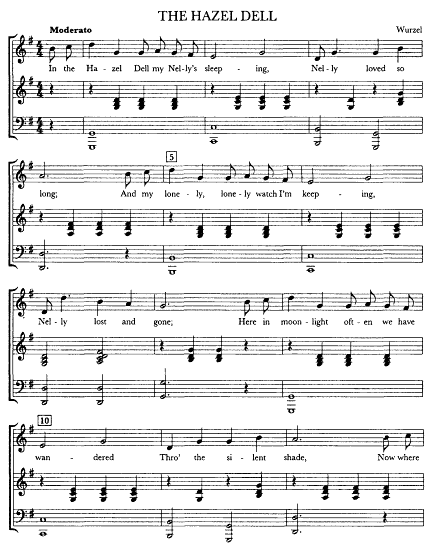
Example 13.
G. Friedrich Wurzel [George Frederick Root], "The Hazel Dell" (Crosby)
(New York, 1852); after George F. Root, The Story of a Musical Life:
An Autobiography (Cincinnati, 1891), 234
(continued )
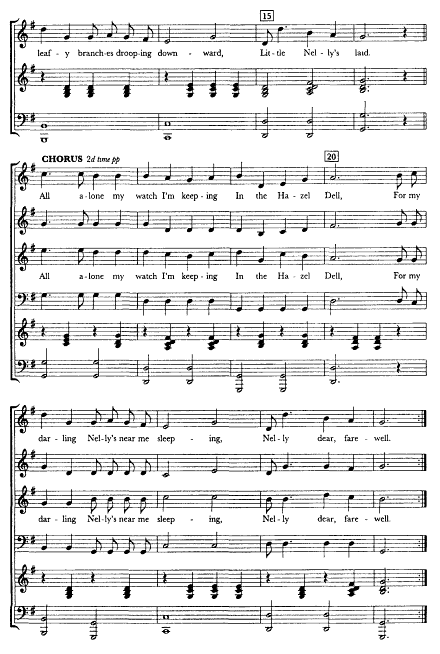
Example 13
(continued)
constructing songs as a self-conscious craftsman, he found them, coming upon tunes, and sometimes texts as well, in his creative "reservoir." He once described Henry Clay Work (1832-84), whose songs Root and Cady also published, as "a slow, pains-taking writer, being from one to three weeks upon a song." Root admired his colleague's results. "When the work was done," he wrote, "it was like a piece of fine mosaic, especially in the fitting of words to music."[37] Yet Root's praise leaves the impression that Work's technique of writing songs differed profoundly from his own.
If Root referred to his musical imagination as the "reservoir" from which songs flowed, he says nothing in the autobiography about the reservoir's sources: the conventions that marked the boundaries of subject matter and diction within which he worked as a songwriter. According to Austin, "The Hazel Dell" belongs to the nineteenth-century Anglo-Irish-American genre of "poetic" songs—songs inspired by a parting or the passing of time and pervaded by a sense of dreamlike vagueness: a tradition in which "Oft in the Stilly Night" by Thomas Moore is linked with Foster's "Jeanie with the Light Brown Hair."[38] Charles Hamm locates "The Hazel Dell" on the fringes of blackface minstrelsy, though it lacks dialect or any hint of buffoonery, placing it with songs about departed young ladies with Scotchsnappable first names: Hanby's "Darling Nelly Gray," Foster's "Gentle Annie," Thompson's "Lilly Dale" and "Annie Lisle," Winner's "Listen to the Mocking Bird" ("I'm dreaming now of Hallie . . .").[39]
Austin is no admirer of "The Hazel Dell," comparing it unfavorably with Foster's "Lily Ray" (1850) and finding it "a hasty and mechanical imitation of Foster's style."[40] "The melody," Austin writes, "seems cramped in its octave range; it strikes its highest and lowest notes in every phrase, and treats most of the notes between them as mere decorations of the central keynote." And he goes on to call the rhythm "plodding."[41] With all respect for the opinion of this knowledgeable observer, I think the song's first four measures are enough to explain its appeal. Certainly that appeal does not lie in the harmony, whose only inventive touch lies in the bass's movement to B in bar 3. Most of all, the opening makes its mark through the flexible rhythm of its declamation: the pushing forward of the first five beats, the coming to rest on "sleeping," and the syncopated hitch with which "Nelly" sets the
second half of the phrase into motion. The varied movement within each of the phrase's four bars gives a certain plasticity to its melodic curve. That, coupled with the economy of the text, which, in just eleven words, reveals a glen in the country, a dead maiden, and a grieving lover, were apparently enough to propel "The Hazel Dell" to wide acceptance. It's noteworthy that almost everything in the song has happened by the fifth bar. The rest of the text offers no narrative. It simply elaborates physical and emotional details of the melancholy scene. The music follows suit: Five of the six phrases in each of the three stanzas are sung to the opening melody. Text and music combine to produce a single mood, static as a picture hung on the wall or a quiet pool in the woods. "The Hazel Dell" suggests how much a "poetic" song's success could depend upon catching a mood in one quick, convincing gesture. Once caught, the mood is fixed and meditated upon through virtually unvaried repetition.
What made a song like "The Hazel Dell" appealing to the public who bought so many copies? According to no less an authority on public taste than the English publisher John Curwen, Root and other Americans composing in a similar vein had happened on to a unique, socially useful musical style. As Curwen wrote Root in the 1850s, "We have in England plenty of high-class music, and more than enough of the Captain Jinks kind of songs, but there is a wholesome middle-ground in regard to both words and music in which you in America greatly excel."[42] Curwen's comment suggests a split in English music between "high-class" compositions for the concert hall and opera house and comic songs, presumably of the kind that flourished in music hall performances. The "wholesome middle-ground" Root had discovered in a song like "The Hazel Dell" was both stylistic and social. Less elevated than an aria, more decorous than a comic song, "The Hazel Dell" was not, like most English and American-published songs of the time, composed for theatrical performance. Bone simple, musically and emotionally redundant, "The Hazel Dell" could easily be sung and played by inexperienced amateurs. And indeed, it was primarily for singing at home that it was composed. In one sense, it can be considered a secular counterpart to the hymn tunes Lowell Mason composed, selected, arranged, and published for the new musical customers he began to discover in the 1820s—a musical product fabricated within rigid, market-
inspired conventions. But that view hardly explains why a song like "The Hazel Dell" could make an impact on many Americans.
Historians have advanced reasons for the appeal of such songs, including public naiveté, bad taste, and the absence of alternatives.[43] But such explanations are inclined to treat a song as an independent work of art—one to be judged against songs already in the canon, and hence definers of its "song" norm, which is believed to transcend questions of time and place. By thinking of "The Hazel Dell" as an occasion for experience in its own historical setting, however, one occupies a better position for glimpsing its expressive potential—its ability, in Root's phrase, to "live in the hearts of people." Those people, presumably, included both performers and listeners. From a singer's point of view, "The Hazel Dell" presents an emotional situation as uncomplicated as its musical challenge. The persona of the narrator, into which the song invites the singer to project himself (or herself), is lonely and grieving; but these emotions are expressed in a highly stylized way. In American "poetic" songs of this period, grief is conveyed through words, not music. Musical resources that, at least as far back as the sixteenth century in Europe, have evoked sadness and pain—minor mode, chromatic adventures in melody and harmony, shifts in tempo to reflect unstable emotions—are nowhere to be found in these "people's songs." Here, moods ranging from ecstatic joy to profound melancholy are all set in major mode (as, indeed, are almost all of Stephen Foster's songs). Songs of grief are slower in tempo and declamation than songs of joy. But except for that contrast, and perhaps the character of the piano accompaniment, the chief difference between them lies in their words.
As these remarks suggest, although American "people's songs" of the nineteenth century collectively cover a wide range of emotions, individual songs seldom do. In fact, most are free of emotional complexity. When they do express grief, as in "The Hazel Dell," they do so in a way seemingly drained of passion. Whatever the words assert about the singer's state of mind, the music conveys a clear sense of distancing from the experience, a kind of escape in which, rather than grappling with the sense of loss in the text, the music lyricizes it. Absorbing, diffusing, and generalizing the emotional sting of the laments offered up in such songs, the music has the effect of removing them from the present. Rather than passionate outbursts, they become gentle,
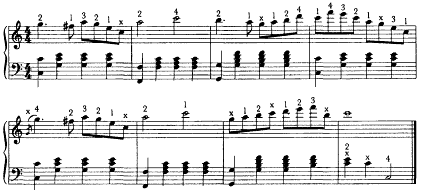
Example 14.
George F. Root, "Kiss Me, Mother, Kiss Your Darling!" (Lord)
(New York, 1864), William L. Clements Library, University of Michigan
often dreamy reveries. While the foregoing may not explain the genesis of this brand of song in mid-nineteenth-century America, it does help to suggest its wide appeal. Coupled with a lack of musical complication, the emotional straightforwardness of the "poetic" song removed any technical or expressive barriers that might have deterred amateur performers from singing and playing these songs. If assuming a "dramatic" role, however momentarily, was part of what encouraged Americans of Root's day to take part in parlor singing as a form of expressive activity, then the role offered by "The Hazel Dell"—dignified, sensitive, wistful— could be slipped into and out of with ease.
Example 14 is offered here as a glimpse into the world of Root's customers. To look at this copy of "Kiss Me, Mother, Kiss Your Darling!" is to sense the earnest anxiety of the pianist who took the trouble to finger the introduction so carefully. We imagine the experience performing must have been for this musician: a tense journey through the intro, strewn with eighth notes and perilous jump-bass chords; relaxation when the simple boom-chuck harmonies arrive in support of the singer's entrance; rising tension as the end of the chorus approaches and the challenge of the introduction, to be played "tenderly," looms again.[44]
But the issue here is not one performer's skill or lack of it. It's the circumstances for which Root's songs were intended. "Kiss Me,
Mother," "The Old Folks Are Gone," and "The Hazel Dell" were only three drops in the ocean of songs and instrumental pieces composed or arranged in the mid-nineteenth century with American amateur performers in mind.[45] Set down in notation and sold in sheet-music form, accompanied by the piano—which by the 1840s had been redesigned and was beginning to be successfully merchandised as the American parlor instrument[46] —these songs mark the emergence of the middle-class American home as a center of musical performance and a prime target of the music business. In the first stage of his career, focused upon teaching classes and group performance, Root carried on, in modernized form, the tradition of the old singing school. Beginning in the 1850s, his composition of songs for home performers brought him into a new arena, perhaps the most volatile, competitive field of the American music business of that day.
Of all the things that historians have noted about Root, one that few have missed is that he used an assumed name as well as his own. The composer of "The Old Folks Are Gone" and "The Hazel Dell" is listed as G. Friedrich Wurzel. Get it? George Frederick Wurzel, the latter meaning "root" in German. It was under this German pseudonym that Root began to write and publish his solo songs. It has been suggested that Root did so in the hope that the name of a German composer might boost the sales of his music.[47] And that interpretation is surely consistent with what is known about the American musical scene in Root's day, including its strong strain of commercialism and the prestige a European pedigree carried. But if one takes the pseudonym as a comment on the structure of mid-nineteenth-century American musical life, another element comes more sharply into focus. By recognizing that when Root began to compose solo songs he began moving away from his professional home base, we can see the Root-Wurzel dodge as evidence of a contrast between musical worlds. The world of teacher-compiler George Frederick Root was one of singing classes, instructional tunebooks issued by book publishers, moral inculcation, invocations and benedictions, and choral performances whose pinnacle of aspiration lay in oratorio excerpts. The world of song-composer G. Friedrich Wurzel centered more on performance by individuals, on sheet music from music publishers, on parlor singing for recreation and enjoyment, and on bringing stage works—from opera to blackface minstrelsy—into the home circle. The latter's secularity and unabashed commercial orien-
tation made it suspect to some who gravitated toward the former, devoted as it was to edification and things of the spirit. When we recall that in Paris in 1851 Root had felt compelled to refuse an invitation to the opera because his church forbade its members to attend the theater,[48] the pseudonym—whether a serious attempt to protect a respected name or a more playfully offered disguise—is not hard to understand.[49]
Beginning in 1852 and continuing for some years thereafter, Root maintained two personas, each with its own identity, separated not only by vocational emphases and institutional bifurcation but by musical style. Root dramatized their separateness by maintaining his career as a teacher-composer while continuing to write popular songs under a different name.[50] And this brings us to The Haymakers , composed in 1856 by Root, not Wurzel, the fourth cantata in the line that followed The Flower Queen .[51]
The Haymakers came straight out of Root's own boyhood experience. He wrote it, words and music both, in his library at Willow Farm, where, he recalled:
by stepping to the door, I could see the very fields in which I had swung the scythe and raked the hay, and in which I had many a time hurried to get the last load into the barn before the thunder-storm should burst upon us. In fact, nearly every scene described in the cantata had its counterpart in my experience on the old farm not many years before.[52]
Calling his piece "an operatic cantata," Root published it with detailed directions for costuming and staging, even to the point of describing how to make, from walnut shells, parchment, and catgut, an imitation katydid to contradict the city-slicker, Snipkins, in one of his songs. (Snipkins: "Sweet Kate never loved anybody but me!" Katydid: "Katydid, Katydid, Katydid." Snipkins: "Katy didn't.")[53]
During Part I of The Haymakers , a crew of happy workers is assembled, mows the hayfield, then beds down for the night to the strains of a choral lullaby. Part II traces the next day's events, beginning with "Good Morning" (ex. 15), a spirited part-song in praise of the dawning of a new summer day. In its ABA form the chorus is straightforward and conventional. In texture it is not, for Root overlays the choral block
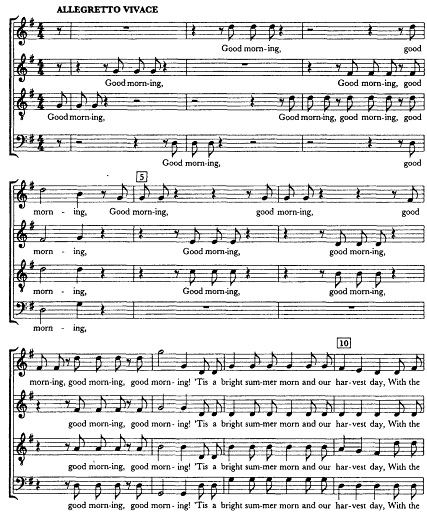
Example 15.
George F. Root, "Good Morning!" bars 1-22 (Root)
(The Haymakers [New York, 1857], No. 23, p. 44)
(continued )
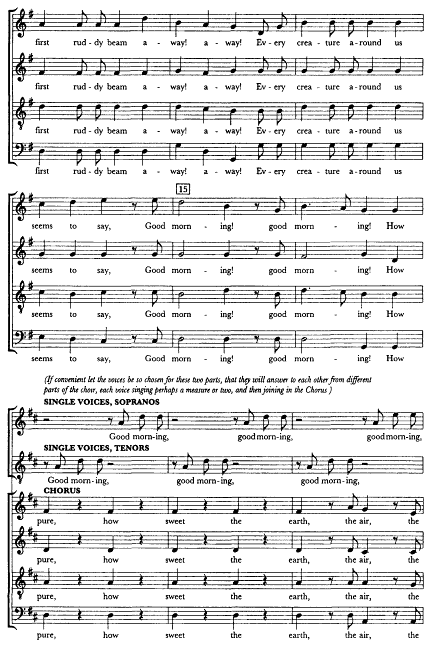
Example 15
(continued)
(continued )
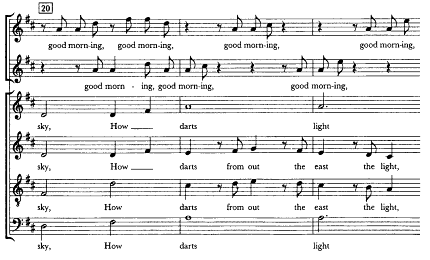
Example 15
(continued)
chords with patter divided among a gaggle of solo voices. The conversational, chattering quality of the solo singers, filling the gaps in the larger chorus's sound, creates a mood of youthful effervescence that seems especially suited to light, untrained voices—presumably those of the singers for whom The Haymakers and other works like it were composed.
The chorus "Shrouded Is the Sun" presents the work's chief dramatic crisis. Haymakers need the cooperation of the weather. They cut the grass in sunshine and warmth. Once it's been cut, they hope the weather holds until the grass has dried into hay, been collected into bales, and safely stored in the barn. In Root's drama, the sky darkens during the gathering, and the workers rush to finish the job. Just after the barn door closes on the new crop, a fearsome storm breaks. And Root's musical treatment of it shows that by 1856 he commanded an idiom that went far beyond that of his Wurzellian "land of tonic, dominant, and subdominant" in an omnipresent major mode, with choruses in block chords and strophic repetition. Here the mode is mostly minor, as befits the subject, but with telling key changes. Opening in G minor, the chorus sings of the gathering storm, with "distant thunders" mur-
muring in the bass (bars 1-16; see ex. 16a). Then, hearing God's voice in the thunder's roar, it modulates to B-flat major as it marvels at his power. Scurrying sixteenth-note scale passages depict "the rushing, howling wind" in G minor (ex. 16b). The trees pitch violently. With the storm's full force about to break, the chorus's awe takes on a note of fear, and its harmonizing gives way to octaves (bars 51-52; ex. 16c). But suddenly, coordinating text, tonality, and texture, Root engineers an unexpected shift of mood. Instead of the chorus in full cry, a quartet of soloists, sounding as if offstage, offers a calming message in B-fiat (bars 52-60; ex. 16c): "Yet fear not we. He, whom the winds obeyed, is master of the storm."
From this point on, the piece is a dialogue between the chorus— louder, more and more agitated as the storm hits with full force, and always in G minor—and the quartet: calm, collected, and in the relative major. At the sound of a mighty crash of thunder, "earth trembles with afright." Then comes the rain, "in torrents pouring down." Finally, struck by lightning, a "mighty oak is riven in twain, as 't were a quiv'ring reed." But each new episode of violent destruction gets the same response from the quartet: we need not fear, for "the tempest but obeys" the heavenly father's will. The B-fiat episodes in the piece not only provide contrast; they intensify the impact of the G-minor sections. As the number ends, quartet and chorus join together for the first time, the former's message prevailing (in B-flat) as the storm loses force and dies away (ex. 16d).
In "Shrouded Is the Sun," Root shows himself able to spin out more than 120 bars of through-composed choral music packing considerable dramatic wallop. Here is the kind of piece—and there are others in the work—that moved John Sullivan Dwight, usually no fan of the Mason-Root school, to review The Haymakers favorably in 1859, commenting that it needed "only the addition of orchestral accompaniment to entitle it to the name of an opera."[54]
Root was not to do much more with his Haymakers style, which brought together elements of the reformed American hymn tune, the English glee, and the Mendelssohnian oratorio. Nor, after Belshazzar's Feast , a "dramatic cantata in ten scenes" (1860), was he to write another work in so rich an idiom. Instead, the events of the early 1860s brought him back to songwriting, this time with militant fervor. In the late 1850s, as convention trips took him more and more to Chicago, he had begun

(a) Bars 1-16, p. 71
Example 16.
George F. Root, "Shrouded Is the Sun" (Root)
(The Haymakers [New York, 1857], No. 36)
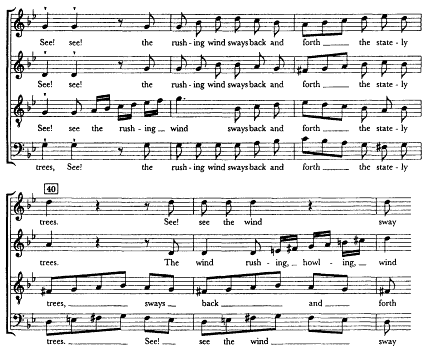
Example 6
(continued)
(b) Bars 37-42, P. 72
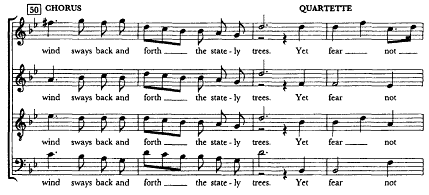
(c)Bars 50-60, p. 73
(continued )
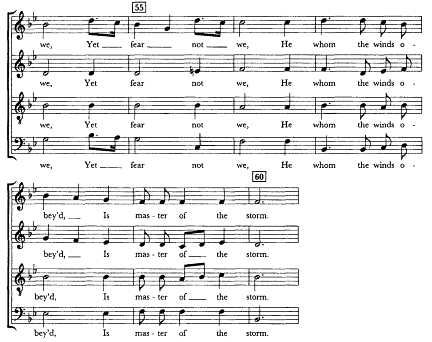
EXAMPLE 16
(continued)
"to play . . . at business" in his brother's publishing firm, and by the time he joined Root and Cady as a partner, he was publishing popular songs under his own name.[55] Root recalled his first years with Root and Cady as quiet ones: "We began to publish a little. First a song or two, and some instrumental pieces in sheet form. After a while we decided to venture on a book, and put in hand one that I was then working on for day-schools; but now the WAR burst upon us!" For the next ten years (1861-71) he found himself caught up in "a whirl . . . of hard and confining work."[56] Again, as in the past, he proved equal to the task that fate brought his way.
Root's description of how he "found" the melodies of his Civil War songs has already been noted. In writing their lyrics, he assumed the role of people's minstrel, seeking to capture and transmute the public's
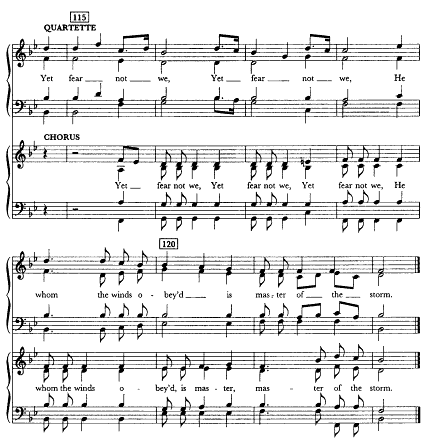
(d) Bars 114-22, p. 76
Example 16
(continued)
feelings. "When anything happened that could be voiced in a song, or when the heart of the Nation was moved by particular circumstances or conditions caused by the war, I wrote what I thought would then express the emotions of the soldiers or the people."[57] Root composed his war songs fully convinced of their moral and material worth in the cause. One Root and Cady advertisement called the songs "munitions of war."[58] "If I could not shoulder a musket in defense of my country," the composer later wrote, "I could serve her in this way."[59]
Root's "The Battle Cry of Freedom" reveals some of the properties that recommended it to those who sang and were stirred by it. One striking feature of this song is the comparative richness of the musical material itself, especially when compared with "The Hazel Dell." "The Battle Cry of Freedom" contains three distinctive, memorable ideas— "Yes, we'll rally round the flag," "Shouting the battle cry of Freedom" (ex. 17a), and "The Union forever" (ex. 17b)—more than the quota for people's songs in general, which could get by on just one. Since every phrase in the song is a statement or variant of one of the three, melodic energy stays at a high level throughout. Dotted rhythms on weak beats tie the three melodic phrases together; and the syncopation in the chorus on the song's highest pitch casts the word "forever" into relief, making it the song's climactic jolt. These elements are supported in the first, second, and fourth phrases by a harmonic twist that reaches beyond the "land of tonic, dominant, and subdominant." A little island of submediant follows the firm establishment of tonic; and after the D major (V of vi) in bar 5, the E-flat triad carries a nice ambiguity: possibly a deceptive cadence in G minor, but really the subdominant, restoring the B-flat tonic. When these musical details are linked with some of the resonant phrases in Root's text—each of the three main melodic ideas is set to a memorable text phrase—there is little mystery why this piece became the Union's most effective and popular martial song.[60]
Root's war songs explore the conflict from many angles. "The Battle Cry of Freedom" was written to inflame patriotic spirits at recruiting rallies.[61] "Just Before the Battle, Mother," in contrast, recounts a soldier's "thoughts of home and God" on the evening before he takes to the battlefield. Another Root favorite, "The Vacant Chair," sets the scene in the home of a soldier who's been killed in battle. ("We shall meet, but we shall miss him. There will be one vacant chair.") And "Tramp! Tramp! Tramp!" takes place in the cell of an imprisoned Union soldier as he anticipates the sound of the marching feet of his comrades, coming, he hopes, to set him free.
In "Tramp! Tramp! Tramp!" the sources that filled Root's "reservoir" of melody are not entirely mysterious (see ex. 18). The verse, from its opening gesture, to its continuation over a subdominant chord on the sixth degree, to its outright borrowing (bar 6, beat 4 to bar 7, beat 3) takes its impetus from the tune to which "The Battle Hymn of the Republic" was sung, right down to the key of B-flat, in which both were
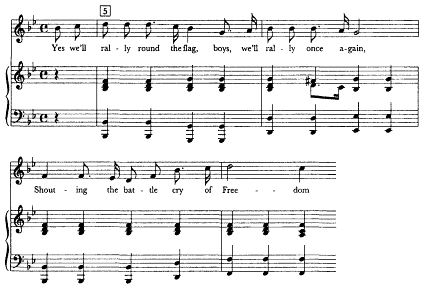
(a) Bars 4-8
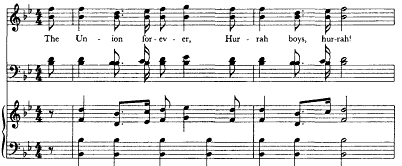
(b) Bars 12-14
Example 17.
George F. Root, "The Battle Cry of Freedom" (Root) (Chicago, 1862)
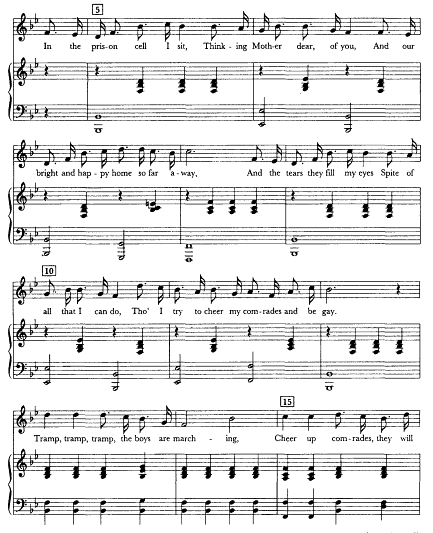
Example 18.
George F. Root, "Tramp! Tramp! Tramp! (The Prisoner's Hope),"
bars 4-20 (Root) (Chicago, 1864)
(continued )
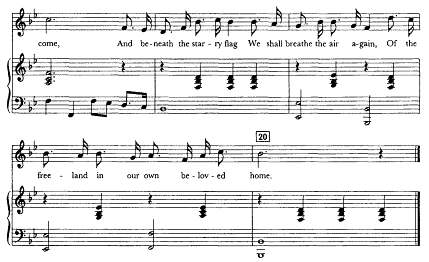
Example 18
(continued)
published as sheet music. As for the chorus, a story about that was told by W. S. B. Mathews in 1889. Speculating about the mysteries of popularity in song, he wrote:
Every popular melody will be found on examination to be very much like something else, generally like a melody by an older and more capable writer. A folks song, nine times out of ten, is a degradation of type, a feebler reminiscence of something better. Very many of the melodies of Mr. Geo. F. Root are very like parts of melodies in opera.
And then came Mathews's story, a parable on the perils of musical evangelism. It seems that William Mason, distinguished pianist and son of Lowell Mason, was once
sitting upon a hotel piazza watching some negro roustabouts unload the cargo of a steamer. As they worked they whistled or sang one melody, which seemed to him exactly like Verdi's anvil chorus [from Il Trovatore ], until a certain point was reached. At
this point they uniformly turned aside and ended Verdi's melody improperly. Hearing this for an hour or more finally awakened a missionary spirit in the conscientious musician, and he strolled down to the wharf to give the dusky singers a lesson, and secure artistic justice to Verdi's music. But when he began to teach them the correct interpretation, he seemed to them to be spoiling their melody, which upon further investigation proved to be Geo. F. Root's "Tramp, Tramp, Tramp, the Boys are Marching."[62]
Root was fifty-one when fire destroyed his business in 1871. Financially well off, he was widely honored as he approached old age, chiefly on the strength of his war songs.[63] On a trip to England in 1886, he was astonished to find that twenty-four pages of the library catalog of the British Museum were devoted to listings of his music.[64] As noted above, London publisher John Curwen had written him as early as the 1850s to compliment him on supplying "wholesome," accessible music for which the British Isles had no equivalent.[65] From that time on, Root's cantatas and songs began to be published in London. And on his trip he met English music teachers who had "taught and conducted my music, more or less, from the beginning of their work—indeed, as one said, some of them 'had been brought up on it' before they became teachers and conductors."[66]
Root's autobiography is filled with insights about the musical traditions in which he worked. While many elements of his world no longer exist, others have endured, and none more persistently than the need for American musicians to position themselves in the marketplace. Root's own success on that score was uncanny. In line with his pragmatic philosophy, his commitment to accessibility, to serving customers' needs in the marketplace, provides the framework for Root's professional life. Beyond that, however, the marketplace becomes an ideal: not just the arena where commercial transactions take place but the forum in which democratic consensus is shaped and registered. Once Root decided to compose for the largest possible number of customers, only the sales of his compositions in printed form and their performances in public and private venues could gauge his success accurately. Thus, The Story of a Musical Life depicts the marketplace as a positive force—the final
measure of achievement—not because it offers musicians a chance for commercial gain but because it is the incorruptible reflection of public judgment.
Root's experience taught him that the ultimate challenge of song-writing lay in outcomes beyond the composer's control. Reception, not composition, defined what he called "people's songs." As Austin has explained, Root's notion of "people's song" was "comprehensive." It encompassed many song genres: home and poetic songs, minstrel and other theatrical songs, patriotic and war songs, hymns and sacred songs, all of which had their own conventions, functions, and audiences.[67] Root enjoyed his first success as a composer, as we have seen, with The Flower Queen . Such pieces caught on with singing classes, providing unpretentious musical dramas well within the capacities of young, inexperienced singers. As artifacts to be sold, cantatas of this kind opened up a new niche in the marketplace, complementing the tunebooks already in general use. At the same time, works like The Flower Queen —"for the use of singing classes in academies," its title page noted—and The Haymakers remained solidly within the realm of instructional music. Published and marketed by Mason Brothers, a tunebook firm, they enriched the musical world that Root had entered when he arrived in Boston in 1838 without challenging its boundaries.
But the example of Stephen Foster showed Root that a much bigger arena lay open to the writer of solo songs. The songwriter's profession used sheet music, not tunebooks, to reach its public, and its purveyors were music publishers, not the tunebook firms who specialized in sacred and instructional music. Root composed "The Hazel Dell" under contract to the house of William Hall and Son of New York, known for effective marketing of sheet music through advertising and a wide network of selling agents. Hall boasted in 1856 that music from its presses could be had "from Maine to Oregon, the Sandwich Islands and Australia."[68] Considering, too, that song sheets were sold to individuals, not whole classes, at prices ranging from twenty to thirty-five cents— cantatas cost between sixty cents and a dollar—sheet music reached people who would never have bought tunebooks or cantatas. Root entered wholeheartedly into the songwriter's profession when success in its marketplace taught him that he had something to say to an audience more diverse than the congregations, singing pupils, and music teachers who had been his first customers. With "The Hazel Dell," "There's
Music in the Air," and especially his war songs, he achieved the ultimate goal of the popular artist: in the words of Greil Marcus, "to discover what it is that diverse people can authentically share." Novelist Raymond Chandler once noted the "vast difference between writing down to the public . . . and doing what you want to do in a form that the public has learned to accept."[69] Not a man to write down to anyone, Root made it a tenet of his professional life never to separate himself from the social order in which he lived and worked and whose taste he sought to please. From that grounding, he maintained a purity of spirit and intent that helped to fill the "reservoir" of musical imagination from which he drew his compositions.
Root's inability to explain his success as a song composer increased his respect for the marketplace. He confided: "I do not think a composer ever knows when that mysterious life . . . that power to retain their hold upon the hearts of the people . . . enters his work."[70] The story of how he composed his best-known hymn tune, "The Shining Shore," confirmed the mystery. One summer at Willow Farm, Root recalled:
Mother, passing through the room, laid a slip from one of her religious newspapers before me, saying: "George, I think that would be good for music." I looked, and the poem began, "My days are gliding swiftly by." A simple melody sang itself along in my mind as I read, and I jotted it down, and went on with my work. . .. Later, when I took up the melody to harmonize it, it seemed so very simple and commonplace that I hesitated about setting the other parts to it. But I finally decided that it might be useful to somebody, and completed it. . .. When, in after years, this song was sung in all the churches and Sunday-schools of the land, and in every land and tongue where our missionaries were at work, and so demonstrated that it had in it that mysterious life of which I have spoken, I tried to see why it should be so, but in vain. . .. I say so much about this little song because it is a particularly good illustration of the fact that the simplest music may have vitality as well as that which is higher, and that the composer knows no more about it in one case than in the other.[71]
In short, the vitality found in a true "people's song" is revealed only by the people's acceptance of it. And acceptance is measured by the
marketplace: the public tribunal to whose judgment Root learned to bow. Root launched his musical career as a teacher who, however modest his own knowledge, prospered by passing on what he knew to a public hungry for what he could give them. But the musical environment he lived in was more than a one-way street. The people, however receptive they might be to Root's teaching, also had something to teach him. For, expressing themselves as a collective entity in the musical marketplace, they could distinguish the few songs that deserved to live from the many that deserved oblivion. No one, including those who aspired to write "people's songs," could anticipate that judgment, nor could it be reduced to a formula or a theory. But neither was there any point in second guessing it.
As a teacher, then, Root gathered, structured, refined, and polished his musical knowledge, dispensing it in classes, conventions, "normals," and instructional books with efficiency and skill to a public of teachers and pupils who recognized his authority. As a song composer, in contrast, he worked quickly and spontaneously, then cast his bread upon the waters of the marketplace, hoping that he had captured something vital and enduring but fully aware that the results lay in the hands of public opinion. This dual relation to his audience—pedagogical authority and control, on the one hand, and compositional deference on the other—seems contradictory to a later age. Indeed, predecessors such as Thomas Hastings and Lowell Mason, contemporaries such as Stephen Foster, and later figures such as Theodore F. Seward and Charles K. Harris took one or the other of these stances but not both. Root and his generation seem to have been the first and last in which the two could combine in one person, suggesting an environment whose leaders understood knowledge and taste to be two different things, each with its own integrity.
Root's aspirations as a song composer affirmed his respect for the instinctive taste of the people. The Story of a Musical Life convinces the reader that, however he may have prospered financially from his musical strivings, Root gloried even more in his acceptance by those from whose ranks he had sprung and whose taste he shared, to his own benefit and to theirs.